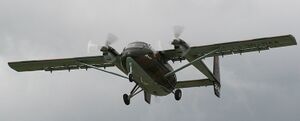Eruere Azimbaw
| Eruere Azimbaw | |
|---|---|

| |
| Azimbaw in flight | |
| Role | STOL transport aircraft |
| National origin | Charnea |
| Manufacturer | Eruere Enterprises |
| Introduction | 1982 |
| Status | In service |
| Primary user | Charnean Army |
| Produced | 1982–present |
| Number built | 254 |
The Eruere Azimbaw (Tamashek: ⴰⵣⵉⵎⴱⴰⵡ, tr. "Bee") is a Charnean turboprop transport aircraft designed and built by Eruere Enterprises. The Azimbaw was the first fixed-wing aircraft to be designed and built in Charnea, and the second aircraft overall following the introduction of the Ashwal. The Azimbaw was designed primarily as a military transport and utility aircraft to suit the needs of the Charnean Army, although it would go on to see limited commercial success in civilian market. The Azimbaw has been accepted into the fleets of a number of short-haul airlines serving remove areas due to its ability to operate without difficulty on unpaved runways and with relatively little supporting infrastructure. In its ongoing military career, the Azimbaw is primarily used for its original intended purpose as a transport aircraft, but has also seen service as a SIGINT platform as well as limited use as a gunship.
Development
The development of the Azimbaw came parallel to that of the manufacturer's flagship project, the Ashwal helicopter. The project was aimed at finding replacements for the Charnean Army's fleet of transport aircraft while Charnean remained under sanctions due to its ingoing prosecution of the Ninvite War. This task was considered of far lesser urgency than that of the Ashwal's development as military transports were being lost in combat at much lower rates than helicopters, and could also be more easily acquired despite sanctions. Nevertheless, the Azimbaw project proceeded with speed. Unlike the Ashwal, which has only limited appeal on a civilian market, the proposed design of the Azimbaw was greatly desired by the civilian market even at the time of its military development as a transport for passengers and cargo which could operate under rough conditions. This in turn led to Eruere Enterprises collecting significant development money from civilian investment in the project, accelerating the pace of development.
The Azimbaw rolled off the lines of the Eruere factory in Ekelhoc directly into military service in 1982. Civilian Azimbaw production would not begin until the end of the war in 1986, which likely dampened its long term commercial appeal. It would, however, still prove a relatively popular aircraft with Charnean and regional airlines and remains a mainstay in the ICA air fleet as well.
Design
The Eruere Azimbaw is a light twin-engine, twin-boom transport aircraft with an ovoid oblong fuselage superficially resembling a blimp. The fuselage is slung between the twin-booms which extend back from the two engine nacelles on its shoulder-mounted wings. The Azimbaw was designed with poor operating conditions in mind, leading to a widely spaced landing gear configuration to improve stability, and the use of wide low-pressure tires to improve performance on rough surfaces and unpaved runways. This also affected the decision to use a shoulder-mounted wing configuration, as this would give the turboprop propellers additional clearance from the ground, helping to prevent damage in such conditions. The main cabin is accessed by large rear-loading clamshell doors, a design feature specifically requested by the Charnean military that had found the side-loading configuration of its older transport aircraft restrictive to the amount and dimensions of cargo that could be loaded. These doors are positioned close to ground level to facilitate loading and unloading of the aircraft, as well as for better clearance with respect to the booms and tail assembly during para-drops.
Variants
- A-1A
- Base model, military transport variant. Use to for medical evacuations, paratrooper operations, as well as personnel and material transport.
- A-1B
- Bomber variant. One built, never accepted into service and later cannibalized.
- A-1A2
- Older SIGINT variant, equipped with ground surveillance radar. Still in service.
- A-1A2B
- Upgrade of A-1A2, equipped with full electronic warfare suite including radar jamming and deception equipment.
- A-2
- Gunship variant, equipped with a chin-mounted 30mm autocannon, wing mounts for 70mm unguided rockets or ATGMs, as well as fuselage modifications to carry and air-launched 500 and 1000 pound guided munitions.
- B-1
- Civilianized cargo transport variant, used primarily by the Charnean National Postal Service for airmail services.
- B-1
- Civilian passenger transport variant, configured to carry 20 passengers in airline-style seating.
Specifications
General characteristics
- Crew: 2
- Capacity:
- 24 fully equipped troops
- 16 paratroopers
- 10 patients with medics
- 3,551 kg (7,829 lb) payload
- Length: 13.03 m (42 ft 9 in)
- Wingspan: 20.96 m (68 ft 9 in)
- Height: 5.21 m (17 ft 1 in)
- Wing area: 43.68 m2 (470.2 sq ft)
- Aspect ratio: 10:1
- Empty weight: 4,000 kg (8,818 lb)
- Max takeoff weight: 7,700 kg (16,976 lb)
- Fuel capacity: 1,663 L (439 US gal; 366 imp gal) (normal)
- Powerplant: 2 × Eruere T1A turboprops, 560 kW (750 shp) each
- Propellers: 3-bladed reversible pitch propellers
Performance
- Maximum speed: 335 km/h (208 mph; 181 kn) at 3,050 m (10,000 ft)
- Cruise speed: 315 km/h (196 mph; 170 kn) at 3,050 m (10,000 ft) (econ. cruise)
- Stall speed: 115 km/h (71 mph; 62 kn)
- Never exceed speed: 397 km/h (247 mph; 214 kn)
- Range: 1,100 km (684 mi; 594 nmi) with maximum fuel
- Service ceiling: 7,650 m (25,100 ft)
- Rate of climb: 6.6 m/s (1,300 ft/min)